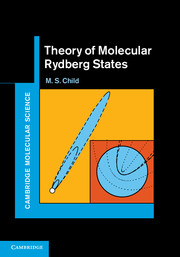Book contents
- Frontmatter
- Contents
- Preface
- 1 Molecular Rydberg states
- 2 The quantum defect picture
- 3 Ab-initio quantum defects
- 4 Frame transformations and channel interactions
- 5 Competitive fragmentation
- 6 Photo-excitation
- 7 Photo-ionization
- 8 Manipulating Rydberg states
- Appendix A MQDT normalization
- Appendix B Alternative MQDT representations
- Appendix C Rotational frame transformations
- Appendix D Optical transition and photo-ionization amplitudes
- Appendix E Generalized MQDT representation
- Appendix F Notation
- Index
- References
2 - The quantum defect picture
Published online by Cambridge University Press: 07 October 2011
- Frontmatter
- Contents
- Preface
- 1 Molecular Rydberg states
- 2 The quantum defect picture
- 3 Ab-initio quantum defects
- 4 Frame transformations and channel interactions
- 5 Competitive fragmentation
- 6 Photo-excitation
- 7 Photo-ionization
- 8 Manipulating Rydberg states
- Appendix A MQDT normalization
- Appendix B Alternative MQDT representations
- Appendix C Rotational frame transformations
- Appendix D Optical transition and photo-ionization amplitudes
- Appendix E Generalized MQDT representation
- Appendix F Notation
- Index
- References
Summary
Introduction
Multichannel quantum defect theory uses scattering methods to provide a uniform treatment of spectroscopic and fragmentation phenomena. It rests on the idea that the exchange and correlation interactions between an outer Rydberg electron and the positive ion core act over a relatively short range, so that the detached electron moves in a purely Coulomb field at larger distances. One therefore thinks, even in the bound state context, of the scattering effect of the non-Coulomb core on the Coulomb wavefunctions. Put in explicit terms this means that the outer parts of the Rydberg orbitals are solutions of the Coulomb equation, the phases of which are determined by matching to the inner wavefunction at the core boundary. There can also be more complicated situations, in which the non-Coulomb interactions lead to energy transfer from the core, which ‘auto-ionizes’ the detached electron from a bound to a continuum state. The general solutions are normalized to allow a uniform description at energies above and below the ionization limit. Further ramifications, which are deferred to a later chapter, allow the inclusion of simultaneous ionization and dissociation. Reviews that emphasize molecular aspects of the theory are given by Greene and Jungen [1] and Ross [2]. There is also a collection of seminal papers, edited by Jungen [3].
This exposition starts with a description of the properties of Coulomb wavefunctions at arbitrary energies, using definitions that provide a uniform description of both bound and continuum states.
- Type
- Chapter
- Information
- Theory of Molecular Rydberg States , pp. 17 - 44Publisher: Cambridge University PressPrint publication year: 2011



